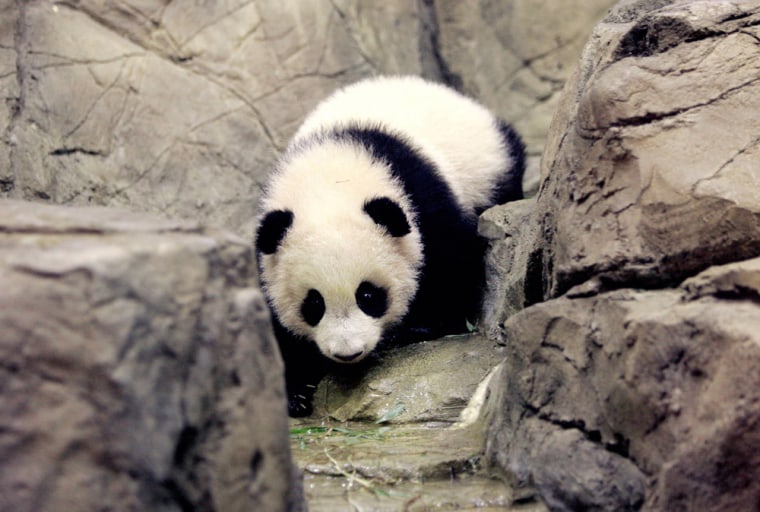So little in Washington is black and white that all it takes is a tiny panda cub to captivate the entire U.S. capital.
Tai Shan, the 21-pound baby panda born in July at the National Zoo, took his first bow before the media on Tuesday, reducing one of the hardest-bitten press corps in the world to cooing and incoherent babble.
Although he is already famous thanks to the zoo's online "panda cams," the little bear won't formally meet his public until early next month.
Demand for tickets has been feverish, with the initial batch of 13,000 snapped up within two hours from an overwhelmed Web site.
In his debut before some 100 members of the international media from more than 50 outlets, Tai Shan showed every sign of relishing the attention.
Carried in from his den into the indoor public exhibit, the fluffy cub struggled to get down from his handler's arms and nipped at her jeans as she walked away.
He then shook his head and began clambering over the rocky display on wobbly legs, taking a couple of tumbles along the way and nosing at everything in his path.
Tai Shan, whose name means "peaceful mountain," is top of the chart for growth. Zoo officials say he is becoming more assertive by the day, squealing and barking when he is picked up and chasing his keepers around his indoor enclosure.
"He is very anxious to go outside," panda keeper Nicole Meese told reporters, adding that the baby will get his wish within weeks.
Meanwhile, zoo staff are busy panda-proofing the place inside and out by filling in holes and gaps.
"Anything a cub can fit into was fixed," Meese said.
Preserving the health of Tai Shan, who was named last month according to Chinese custom and after an online vote by more than 220,000 people, is crucial given how hard it is to breed giant pandas in captivity.
Females only ovulate once a year, with a slim 24-to-48-hour window for breeding. In programs in China, officials often inseminate up to five times, a process that can exhaust the prospective mother who has to be anesthetized each time.
"We were aiming to do just one insemination," Jo Gayle Howard, the zoo's reproductive scientist, told Reuters. "We had done enough research here and in China to feel very confident that we got that timing right."
Tai Shan is the first cub for mother Mei Xiang, who has proved an instinctive mother. He is now dependent on her for milk but will graduate to the staple panda diet of bamboo shoots at around six months.
Male pandas pose their own breeding problems and zoo staff reckon father Tian Tian was unable to create his son the natural way because of positioning issues.
"It is a little easier to get things right for the female," Howard said. "But it really is up to the male to grab the female, get the positioning right and start breeding."
Su Lin, a girl panda born this year in the San Diego zoo, was the rare product of natural mating in captivity.
Mei Xiang will be ready to breed again in a couple of years and the Washington-based zoo plans to try to mate her with Tian Tian again in 2007.
The couple is on a 10-year loan from China and any babies it produces belong to Beijing. Tai Shan is due to return to his ancestral land when he is two years old.
This cub you see today is an ambassador for all the work the National Zoo is doing to save giant pandas," Howard told the news conference. The zoo has launched a campaign to raise $400,000 in 2006 for panda research.
With only 1,600 left in the world, the black-and-white bears have come to symbolize endangered species everywhere.
The giant pandas are the best-known residents and the latest breeding success for the Smithsonian Institution's National Zoo, which has weathered a series of setbacks including a string of large animal deaths.
